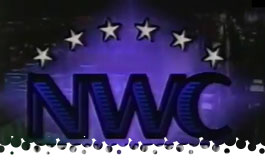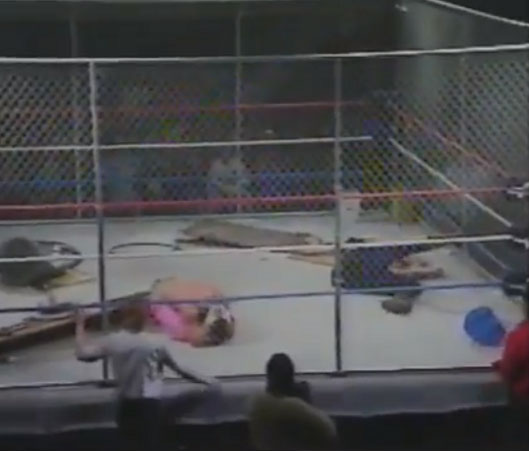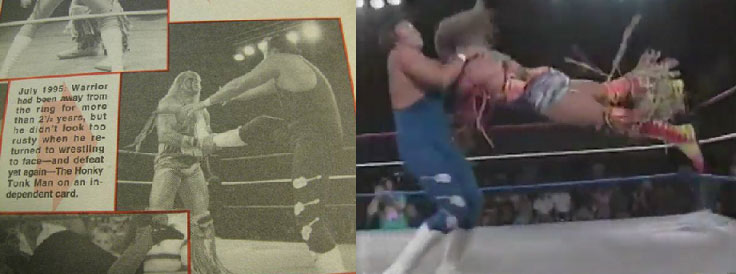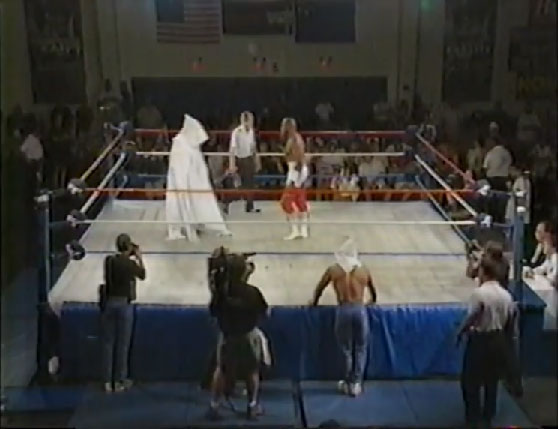The History of the National Wrestling Conference
by Scrooge McSuck

The first half of the 1990's wasn't a kind period for the world of professional wrestling. The "glory days" of the territories was all but dead, with only a few hopefuls clinging to life. The World Wrestling Federation gradually lost their audience, hit even harder once the steroid and sexual misconduct scandals made it to the mainstream press. World Championship Wrestling constantly struggled to find their identity as the direct competition to Vince McMahon, wavering from promoting legitimate athletes and skilled performers to going the route of targeting children with over-the-top cartoon characters. No matter the game plan, wrestling was losing its popularity, and the boom period ushered in by the rise of Hulkamania was clearly over.
The Fall of 1990 brought the expected demise of the American Wrestling Association (AWA), Vern Gagne's long-operated promotion based out of Minnesota, leaving the World Wrestling Federation and World Championship Wrestling (formerly Jim Crockett Promotions' piece of the National Wrestling Alliance) as the two mainstream wrestling promotions on the map. AWA didn't leave much behind, with a thin roster of talent and a miniscule fanbase for much of their last year or so of existence. What they did have, was a national television deal with ESPN. You could argue the deal wasn't the greatest, victims of preemption and delays due to more important broadcasts, but TBS did the same with JCP/WCW programming that were scheduled after Atlanta Braves baseball games, so the excuse, while it has legs to stand on, isn't a strong enough one to call it a bad deal. After all, television is an essential aspect of a successful promotion, and without it, you can only go so far.
As the 90's marched on, promotion after promotion tried planting their feet in the ground. Herb Abrams' UWF featured a decent collection of talent, considering how loaded the rosters were under Vince McMahon and Ted Turner's ownerships. They also scored a deal with SportsChannel America, a regional affiliate that would be succeeded in format (and success) by FSN. Joe Pedicino famously shopped around the idea of jump-starting the recently abandoned Dallas territory, claiming to have funding from, and I'm saying this 100% honesty, a NIGERIAN PRINCE. No, the $25 million never materialized, but Pedicino helped get the Global Wrestling Federation off the ground, and they scored an ESPN deal in the Summer of '91.
Pedicino wasn't the only promoter to score a deal with ESPN. Angelo (and later his son Mario) Savoldi operated out of the Northeast, mostly in Massachusetts, with International Championship Wrestling, running shows throughout the 80's. By 1991, the small promotion entered a working agreement with Kevin Von Erich, and rebranded the promotion International World Class Championship Wrestling, or IWCCW for short. Like the GWF, the IWCCW was featured daily on ESPN, with matches rebroadcast over and over to fill the time. Like the UWF and GWF, the deal didn't last long, and the company was quickly and quietly forgotten about.
Fast forward to 1994, and the cycle seemed to begin anew. Paul Alperstein, based out of Chicago, IL, shopped around his own concept for a wrestling promotion: The American Wrestling Federation. Unlike the ESPN and SportsCannel America deals, Alperstein paid his way onto networks, including the MSG Network based in the New York Metro area, spending several million dollars for the first bath of tapings to make it to television. The AWF featured some stars of the 80's who weren't considered valuable enough to be picked up by either the WWF or WCW, as well as some unproven up-and-comers, and there lies the problem, and a problem that would lead ultimately to failure every time: relying on the past wasn't going to make anyone money. When the lineup finished the broadcast run, and there was little interest in the product, the company went on hiatus, came back briefly in 1996, and folded permanently as far as Alperstein's involvement is concerned. I did a quick search and found a "AWF" still operating, but it seems to only exist as a successor in name only.
With failure after failure, one has to look at the one company that may have been doing it right. Paul Heyman, best known to the wrestling audience as Paul E. Dangerously, was controversially let go by WCW in early '93, and soon began a working arrangement with Tod Gordon for a company called Eastern Championship Wrestling. Slowly, the company developed a hardcore audience of bloodthirsty fans, witnessing violence unlike anything seen in North America, in a cramped Bingo hall. While ECW (which would change to Extreme Championship Wrestling in the Summer of '94) would book "known" talent, they put more emphasis on creating their own stars, and quickly moved away from the relics of the past as top of the card performers that weren't willing to do business. While ECW never had the greatest TV deals, having late-night broadcast times, and constantly having to fight networks to put the show on in the first place, they did succeed in being able to make money at the gate and distributing tapes through RF Video. Finally, a small operation was able to succeed, using progressive thinking over the ideas of rehashing the past in a sure-to-fail get-rich-quick scheme.With that all on the table, we finally get to the subject of today: The National Wrestling Conference. You're no doubt thinking to yourself "what the hell is the National Wrestling Conference", and I can't argue against it. Even when I was a youngster thumbing through issues of Pro Wrestling Illustrated, the NWC didn't leave much of a mark on the world of professional wrestling, with the exception of one subject that we'll get to in due time. It was that one little note in time that put the company on the map of my fandom, but it's not where our journey begins.
The first mention of the NWC, based out of Las Vegas, NV, was in the October 3rd, 1993 issue of Dave Meltzer's "Wrestling Observer Newsletter", a quick blurb mentioned in the "Here and There" section that was for Independent promotions or talent without a steady affiliation or reputation. The NWC would debut on October 8th, 1994 at the Aladdin Hotel, featuring a Main Event of Tito Santana vs. Terry Funk. Curiously featured (head-to-head no less) are Nailz and Brutus Beefcake. Nailz is best known not for what he did in the ring for his short stint with the WWF, but for the backstage incident where he physically assaulted Vince McMahon over a pay dispute. Beefcake was currently a contracted talent to WCW, so maybe they had a clause in their contracts that allowed outside work under specific conditions (like no WWF guys on the show). We've also got marginal names like Bobby Bradley (a long-time enhancement talent for the WWF), the Power Twins (a tag team used often by Abrams' UWF) and "The Pitbull" Gary Wolfe, who had yet to gain serious traction with ECW. There's one more name on the booking sheet that rings a bell and is likely the biggest piece to the early success of the NWC... Sabu.
As we've touched on earlier, the early 90's was the era of cartoon characters and in the case of the WWF, moved far away from blood. While Deathmatches were becoming more common overseas, particularly in Japan, in North America, Sabu was a pioneer of the extreme hardcore style, and was a hot commodity for independent promotions. Though Sabu's most well known tenure was in ECW, promoters knew Sabu brought eyes on their product, and became one of the most popular wrestlers of the mid 90's with his reckless abandon and willingness to hurt himself for the entertainment of the audience. The stories of Sabu;s injuries are legendary, as well as the use of super-glue to close gashes on his body so he could keep working without paying for medical aid. Sabu would face and defeat Bobby Bradley on the October 8th card, but his time to shine at the top of the card was to come. Three weeks later, the NWC returned for their second show, held in Las Vegas' Silver Nugget Pavilion. Sabu would headline the night with Cactus Jack in a "Desert Death Falls Count Anywhere Match", a wild brawl that took them outside the confines of the ring area and interrupted a game of blackjack. The rest of the card featured the usual undercard guys, names such as "The Volcano Kid", Tim Patterson, Billy Anderson, and "The Thug", but as long as the guys on top were performing and drawing well, it didn't matter what else was on the card.

When the NWC returned to the Silver Nugget on January 13th, 1995, they nearly tripled the previous show's attendance with a rematch between Cactus Jack and Sabu, this time held inside of a Steel Cage. While the hardcore fans could appreciate it for the expected brutality that came with their names and prior match, a decent chunk of the audience came on the backs of seeing the Junkyard Dog in action, working the Semi against one of the Power Twins. To say the reaction to the violence and blood wasn't something they expected to see. Again, the undercard was mostly flawed. One correspondent for the WON credited the 65-year old midget wrestler Lord Little Brook for having the second best match on a card that also featured an early appearance of the 7'2" Ron Reis as "SWAT." Later that year, Reis would find himself replacing Jorge Gonzales as the mysterious "Yet-AY" for WCW, before being repackaged as the world's largest (and slowest) Ninja. I love professional wrestling and the kooky quirks that come with the territory.
With a show booked on February 11th, and Sabu unavailable, TC Martin went to the well for what worked and brought back Terry Funk to headline against Virgil, who was let go from the WWF sometime in the late Summer of '94. Funk, despite pushing the age of 50, was adapting to the new style that was in demand, and not only that, was willing to make others look good in the process, often letting people go over to strengthen their stock. Virgil, on the other hand, was the complete opposite. With an inflated ego of WWF fame, Virgil was a difficult talent to work with, and was known to refuse doing jobs. The two would wage war in a match featuring a branding iron, and arguably might've been the best match Virgil had thanks to the one-man show that was Terry Funk. The Junkyard Dog was in attendance again, announced for an Arm Wrestling Match with the Iron Sheik, but the Sheik ended up replaced by "The Thug". At this point you're probably wondering, "did this promotion hold Championship matches?" Yes, technically Tito Santana was their inaugural Champion, but he hasn't appeared for the group since their first date.
With Santana out of the picture, the NWC Championship was held up, with it awarded to the winner of a Chain Match between Sabu and Terry Funk. It was another wild brawl (and loosely using the gimmick, as they would remove the chains for the sake of doing some spots) with Sabu coming out on top as the NEW NWC Heavyweight Champion. It was another lackluster undercard, with Virgil going over Larry Power, the Junkyard Dog defeating The Thug, and THE TONGA KID making an appearance, teaming with the Volcano Kid. With them burning through several matches between Cactus Jack and Sabu, and Terry Funk out of the picture for the upcoming show, it's curious to see what would come next for the promotion. What new trick was up the sleeve of Mr. Martin? Unfortunately, it's going back to the past.
Drawing its smallest gate of 1995, the NWC came back to the Silver Nugget on April 14th with a Main Event of "Hacksaw" Jim Duggan vs. Jim "The Anvil" Neidhart, and a Semi of the Junkyard Dog vs. Mr. Hughes. In neither case did the match end with a conclusive finish. With a local television deal coming into the picture, some talent worked double duty, including the aforementioned Hughes and Neidhart. The best match of the night by a wide margin was between Bobby Bradley and the up-and-coming Rob Van Dam. The duo would soon be paired together and branded "Aerial Assault", although I don't recall Bradley being much of a high-flyer. The heavy emphasis on old school names might come from a reputation that the booker, TC Martin, was a "mark for the ex-WWFers." Again, this was reported in the WON (May 1st, 1995 issue), so who knows the source. An unhappy local guy? Maybe one of the very same former WWF guys who didn't mind stooging that a money mark was available? Either way, without the blood and guts on top, the show wasn't nearly the success it was, but it wasn't an alarming drop.
Sabu returned to defend the NWC Heavyweight Championship, defeating Jim Neidhart on top of the May 12th card that drew less than the prior date. Maybe the bloom was off the rose, even with more former WWF names on the card. The Junkyard Dog was back again, defeating the Iron Sheik, who on the same night, did the Club swinging challenge and worked over a plant in the crowd. We also saw the debut of the Honkytonk Man, taking a DQ loss against the Man, the Myth, the Legend that is Virgil. With the television deal projected to begin in early July, the NWC needed some juice, and maybe some bigger star power than a washed-up Junkyard Dog (who may have popped one gate, but clearly wasn't in further appearances) or Virgil. With some goings on behind the scenes, and a big name coming available, it was time to come up with an idea to introduce his arrival to the promotion.
On June 24th, the NWC put on their normal standard with a Four-Way Elimination Steel Cage Match, with the NWC Heavyweight Championship on the line. Sabu successfully defended against Cactus Jack, Mr. Hughes, and Virgil, with Sabu vs. Cactus taking up the last 14:00 of a 35:00 match. In the Semi, the Honkytonk Man defeated the Junkyard Dog by blasting him with guitar, and in the post-match, bragged about the lack of competition and having an open contract to face anyone. Before the Main Event, when running down a preview of next week's card, Martin (who usually performed ring announcing duties) said there was someone interested in that open contract, and on July 22nd, the challenge has been accepted. The Honkytonk Man will take on the man making his debut in the National Wrestling Conference... THE ULTIMATE WARRIOR.
With the Warrior's final mainstream appearance (for the WWF) coming in the Fall of 1992, he had mostly vanished from the eyes of the wrestling world. With a ridiculous asking price and a penchant for changing his mind on a deal, the Warrior's only known work was an overseas tour in the Spring of '93, working exclusively with former WWF rival, Hercules. The Warrior name would pop up here and there, and was on the radar of WCW before they settled on a clone called "The Renegade" that did nothing but piss off the original Warrior (birthname Jim Hellwig, legally changed to Warrior for the sake of owning his gimmick) and drive a wedge between himself and a friend that he held responsible for getting Rick Wilson (the man playing the Renegade) into the business. Knowing the reputation and price tag that came with Warrior, Martin booked accordingly to work Warrior's appearance fee into the budget, and running the show with mostly unknowns and locals, with the exception of Warrior (of course) and the Honkytonk Man. With the Warrior coming in to boost the gates, and their TV deal finally kicking off the weekend of July 8th on KFBT, things were looking like they were heading in the right direction.

July 22nd comes, and the show comes and goes without much drama from the Warrior. The WWF wasn't to happy with the original promotion of "Ultimate Warrior", forcing them to simply introduce him as "The Warrior" to avoid legal entanglements. Warrior looks to be in great shape for a 38-year old that was heavy into steroid use and hasn't worked in over two years. Maybe a little too good. The steroid scandal that rocked the WWF was still in the back of everyone's minds, and Warrior shows up for a wrestling gig looking like that news never made it to his home planet. The show sells out, but when you've only got room for 1,300 or so fans, I don't know if Warrior's appearance was going to boost live business beyond the appearance, but it did factor in my exposure to the NWC. In a Fall '95 issue of PWI, there was a small article on Warrior's return to wrestling, with photos of the event used. Heck, Warrior even ranked in the 1995 PWI 500 based on his one match with the Honkytonk Man, falling somewhere in the low 300's if memory serves me correctly. For years, this was my only knowledge of the promotion, but it stuck with me until media streaming blew up and content from the promotion found it's way to those few who randomly searched "NWC wrestling" late at night.
The WWF might've been cool with Warrior doing a live appearance, but as soon as promos were to air on NWC Slammin, threats of legal action were sent to the station, causing the show to be pulled for the week, rather than edit out the few minutes that would've featured Warrior. With a return date scheduled for August 25th, the plan was to move on from the Silver Nugget and move back to the larger Aladdin, which could hold a (reported) 5,000 more attendees than the Silver Nugget could. Unfortunately, the NWC suffered a major setback when their financial backer filed for bankruptcy. Warrior, seeing the opportunity, stepped in and offered to back the company under conditions it would be rebranded under his own name, and would receive a certain percentage of all money coming in. Without another option on the table, Martin and Warrior agreed to the terms of Warrior's conditions, making him partial owner of the company. Warrior wouldn't appear on their next show, nor was he advertised. Instead, they brought in Sabu and Cactus Jack to headline a card filled with matches to determine the 1st set of Tag Team Champions (including bringing in the Powers of Pain and Bushwhackers), crowning Rob Van Dam and Bobby Bradley as the eventual winners of the tournament. While the company could boast selling out, or at least coming close to that number for most of the year, this show only filled half of the usual capacity, even with Sabu and Jack on top. With the same poor undercards and little changes on top, it's easy to see why such a sharp drop would take place, especially a month after trotting out the Warrior. Attendance was now down, and their TV was inconsistently featured, only put on hiatus not long after starting. Maybe the threats from WWF were too much, or maybe the controversial (and tasteless) angle where men in white hoods assaulted Virgil wasn't in the least bit entertaining made the executives second-guess the decision to feature non-WWF content on their stations. Whatever the reason, the TV deal came and went so quickly, almost as if it never was there to begin with

The newfound relationship with Warrior would sour immediately. Scheduled for October 7th, Warrior was to headline against Jim Neidhart, as well as making personal appearances to promote the show and drive ticket sales. According to the WON (issue dated October 16th, 1995), Warrior arrived 12 hours later than he was scheduled for one appearance and blocked any incoming phone calls to his hotel room. Warrior would no-show the rest of his commitments, but made sure to pocket all the money he was offered to make the appearances, as well as all the money from ticket sales that evening, leaving the company high-and-dry without their biggest promoted star and without the funds to pay talent. The lineup was adjusted for the night, including burying Warrior on the way out. With some talent unpaid for the show, no backers, and no television deal, the future for the NWC looked bleak.
No further events were booked for 1995. The company would hold their first even in more than half-a-year on May 17th, 1996, going back to what they relied on in the first place: Sabu on top, a collection of former WWF guys, and poor under-cards with cheap, local talent. The long hiatus crippled the local goodwill the company had developed, drawing no better than 500 for the pair of shows they ran in the Spring before another lengthy hiatus. The NWC would run shows based out of Sacramento in 1997 and 1998, with Jake Roberts headlining most of their final events. Heck, they even got former Major League baseball star STEVE SAX to appear as a guest referee! Unfortunately, by this point, the wrestling business recovered immensely, with both WCW and the WWF thriving and snatching up any talent they could find. ECW, the innovative company that launched the style of wrestling that was refined into the "Attitude" era of the WWF, was now on the ropes, having dug into their bag of tricks and stumbling to keep their financial heads above water without a solid television deal. It amazes me, that when the wrestling popularity was down, networks were willing to give chances to promotions with zero credibility, but at the hottest point, you'd be hard pressed to find anything but the big 3 getting television contracts.
Did NWC leave behind any kind of legacy? The easy answer would be no, since most of the wrestling world likely never heard of the company, but there's that little bit of shine and national press they received with Warrior's involvement, which leads us to the old story, "never do business with Warrior, because he's a con-artist pr*ck", but the way they structured their bookings should be given a little bit of respect, even if it was only a short-term boon. While some companies tried too hard on promoting the past, and NWC was guilty at times of this too, they were smart enough to book matches on top that were hot with the independent scene, and loaded up with local talent to adjust for the costs of flying in these stars that were in high demand. If you're wondering if any of their young talent became anything, I don't think so, at least not in the United States. These days, owner TC Martin still works in the world of sports, hosting radio programming and lending his voice to televised broadcasts. Give him a follow on Twitter @TCMartin21 if you'd like, though he rarely mentions pro wrestling, but doesn't hide his past, either. If you're curious to check out footage of the NWC, there's a few videos floating around, but after detailing the history of the company, I don't think I'd recommend binge watching, but maybe a skim of one of their weekly shows just to see how they produced their TV content and how they sold their product to the local market… so stay tuned as I make myself miserable recapping some of it. COMING SOON.
Comment about this article on Da' Wrestling Boards!